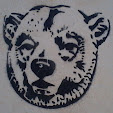However, I do love chess sets, especially
when they are more figural in execution . . .
. . . like this one.
This is my Christmas present - which is why
I've obscured the price! I grabbed it when I was told about it and someone else
is wrapping it, but only after I'd shot the pictures necessary to show it to
you!
This shot was taken where it sat on display
in the little antiquity/craft place while I asked them to hold it for a couple
of days while I rounded up some funding, and at first glance I thought I was
probably buying an Indian chess set, aimed at modern tourists in the same
terracotta we've seen here before, with 'Black' being Thai/Siamese or Burmese
troops, White: Indian or Tibetan/Nepalese types?
The pack-animal Knights looked a bit odd,
but who knows what they've got in the Himalayas or jungles of Burma which David
Attenborough hasn't got round to showing us yet, huh? And you never look at
something the first time you see it in the same way you do when you settle down
at your desk for a second (proper) look; many a twinge of 'buyers-remorse' is
down to a glance and incorrect conclusion.
The 'Thai/Burmese' side, or are they the
Indians fighting a Chinese white-force? Well, it turns-out they are none of the
above, they are in fact Amerindians! And speaking of Chess conventions - as I
will in a minute down the page - this is the correct way to photograph a chess
set - King to the left, Pawn to the right and if it's a more standard set like
a Staunton, you'd add a Pawn or King
from the other side at one end of the row.
As we'll see in a minute, once I'd got the
set home and looked at it properly in was obvious that White are actually Conquistadores
and these chaps . . . well? Probably Peruvian . . . or Columbian maybe? I think
the pack animals rule out Mexico, while to the south of the Amazon-basin dress
is different, with warmer, layered-clothing and felt or woolly-hats.
The thing is, I don't mind they're not from
India (or that part of the world) as I have the figures we've previously looked
at (a lovely set coming here soon!), but I have had no South American
composition; now I have, so a bit of a bargain!
The clincher was the White set, which while
looking Asian at first glance, especially against the other set, are actually,
clearly Europeans of the Columbian invasion era. I'd mistaken Spanish helmets
for Sikh turbans or Nepalese side-hats!
Both sets are presumable thumb-pressed into
loose half-moulds, married-together and then turned-out to dry, possibly with a
low-temperature firing to speed things along. [There is a page in preparation
which explains why this type of clay is 'composition' rather than 'ceramic',
but it's proved problematical, been re-written twice and was passed around the
experts for proof-reading nearly a year ago to little effect!]
The figures have then been hand-painted,
and glazed with a dip in what appears to be pigmented yacht-varnish . . .
'army-painter' before Armypainter!
There is a strong and obvious overtone of
Christendom to White, reinforcing the history behind the two sides in this set,
not the Bishops but both King and Queen being adorned with large crosses (I
also missed in my initial perusal), with the Black side equally obviously being
representative of pre-Colombian Amerindians.
White's Knights are henceforth to be known
as 'My Little Surprised Pony', while Black's will be 'My Little Andean
Not-a-pony', whether it's a lama, alpaca or other, similarly-configured woolly
ruminant from that continent (there's several) is anyone's guess. You can also
see how the two halves are squished-together and roughly flattened-off before
being tipped-out of the moulds.
My use of Black and White has no racial
undertones whatsoever, despite the ethnicity of the pieces, it is simply Chess
convention to call the paler side 'White' and the darker side 'Black' in cases
of polychrome sets - where you [occasionally] get those beautiful stained-ivory
sets (ironically; from India!) in green and red, I believe the convention is
always Red = black and Green = white, but - obviously - with African soapstone
and carved-wood sets, black is black and the red/oxblood is white!
Note also, that while Black's Bishops and
Pawns are different designs, the grotty-old euro-pirates get a scale-down OF
the Bishop AS a Pawn! And everyone looks as surprised as White's Knights,
except the Andean Not-a-pony's who look very sly and not less than a little
evil!
Lined-up and ready to go, playing with
polychrome sets is even more of a nightmare for me as it's too easy to misplace
ones pieces, especially with this set where I'd be losing some Pawns mentally, out
of the corner of my eye, as fast as I lost others physically to my opponent!
However another miss-assumption was the age
of the set, I thought when I first saw them that they were modern; like
yesterday, but studying the - minor - damage/ageing to the board I suspect it's
more of a 1960/70's thing?
I shot the hell out of it because it'll be
three months before I see it again! If there's one criticism of the set, it's
that Black's castles are a cop-out - European outline, medieval turret-towers; they could have been
steeply-stepped pyramids, or something more colloquial, or at least recognisably
Amerindian.
PS - A quick Google while uploading this post reveals they are quite common, definitely from Peru and while the designs differ, the theme remains the same - Inca vs. Spanish. There's one with a lovely red/orange board offset by 45º's as a diamond/lozenge and others have round boards or more ornate ones with feet - look for the photograph of a stall loaded with them!









No comments:
Post a Comment